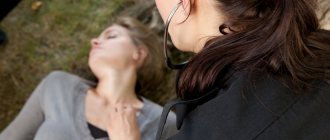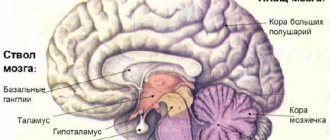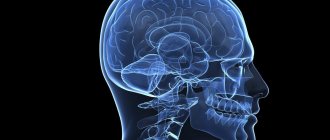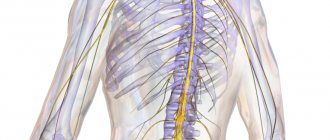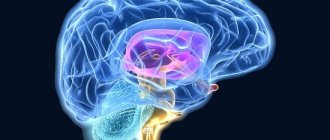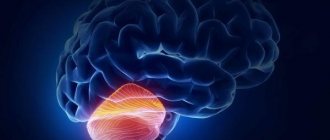general information
The anatomy of the spinal cord differs from the brain in its oblong structure. In Latin the organ is called medulla spinalis. It is a thickened tube with a small channel inside, slightly flattened in front and behind. It is this structure that ensures the normal transportation of nerve impulses from the main organ located in the cranium to the peripheral structures of the nervous system.
Locally, the organ is located in the spinal canal, where soft and bone tissues and nerve endings responsible for many functions of the human body are concentrated. Without a normally functioning spinal cord, natural breathing, digestion, heartbeat, reproductive activity, and any motor activity are not possible.
In humans, it begins to form at about 4 weeks of development inside the mother’s womb. But in what form it is observed in an adult, it appears much later; at first it is a neural tube, gradually developing into a full-fledged organ. It completes its formation within 2 years after birth.
Structure
The local location of the spinal cord along the entire back has its own characteristics. This physiology ensures that the organ performs its basic functions. The organ begins at the level of the 1st cervical vertebra, where it is gently rebuilt into the brain, but there is no clear division in them. At the junction there is a crossover of the pyramidal tracts responsible for the motor activity of the limbs. The spinal cord ends in the region of the 2nd lumbar vertebra, so it is shorter in length than the entire spine as a whole. This feature allows lumbar puncture to be performed at the level of the 3-4 lumbar vertebrae, without the risk of damaging the spinal cord.
What is special about the structure? The oblong tube has two grooves at the front and back. The brain is covered by three membranes:
- Solid. It is the tissue of the periosteum of the spinal canal, followed by the epidural space and the outer layer of the dura mater.
- Cobweb. A thin, colorless plate that fuses with the hard shell in the area of the intervertebral foramen. In the place where there is no fusion, the subdural space is located.
- Vascular. A soft membrane separated from the previous one by a subarachnoid space with cerebrospinal fluid. The membrane is adjacent to the spinal cord and consists mainly of choroid plexuses.
The space between them is filled with cerebrospinal fluid - cerebrospinal fluid. The gray matter is located in the center of the organ. It consists of intercalary and motor neurons. It also contains two types of horns: the anterior ones, which contain motor neurons, and the posterior ones, where interneurons are located.
No ads 1
External characteristics
The external structure of the spinal cord largely follows the contours of the spine, since the structures adapt to its physiological curves. Two thickenings are observed in the area of the neck and lower thoracic, the beginning of the lumbar calving. These places are characterized as exits of the roots of the spinal nerves responsible for the innervation of the arms and legs.
The external structure can be briefly described by the following characteristics:
- The shape is cylindrical, flattened on the front and back sides.
- Visually, the spinal cord looks like an elongated “cord” with processes.
- On average, the length of the organ is 42-44 cm, but directly depends on the person’s height.
- The mass is 34-38 g, which is 50 times less than the organ of the brain.
- There are two grooves in front and behind, which visually divide the organ into two symmetrical parts.
- In the middle there is a canal, which in the upper part communicates with one of the ventricles of the brain. Inferiorly, the central canal expands, forming the terminal ventricle.
The thickness of the spinal cord is uneven and depends on in which part the measurement is taken. The organ also has four surfaces: two rounded lateral, a convex posterior and a flattened anterior. The external structure is in many ways reminiscent of the internal part of the ridge, since the organ fills the entire canal. The organ is reliably protected by bone tissue.
[node:field_similarlink]
Internal structure
The spinal cord is made up of nerve tissue cells called neurons. They are concentrated closer to the center and form gray matter. According to rough estimates by scientists, the entire organ contains about 13 million cells, which is many times less than in the head section. The gray matter is located inside the white matter, and if you make a cross section, it will be shaped like a butterfly. This is especially clearly visible in the diagram.
Schematic cross-section of the spinal cord
This unique anatomy allows the spinal cord to be divided into several structures. It is arranged as follows:
- Front horns. They are distinguished by their rounded, wide shape and consist of neurons responsible for transmitting nerve impulses to the muscles. It is precisely because they perform such a task that they are called motor. The anterior roots of the spinal nerves begin in the anterior horns.
- Hind horns. They are distinguished by a long, narrow shape and consist of interneurons. They bear this name due to their ability to receive incoming signals from the sensory roots of the spinal nerves, otherwise they are called dorsal roots.
- Side horns. They are present only in the lower segments of the organ, and contain vegetative nuclei responsible for the dilation of the pupils, or the functioning of the sweat glands.
The physiological function of nerve endings is to transmit signals from the brain to the spinal cord, as well as deliver received impulses in the opposite direction. This ensures interconnection at all levels and areas of the nervous system. Nerve fibers are combined into bundles and are present along the entire length of the spinal cord.
Metamer and segmental structure
Each part of the spinal cord is a constituent element of a specific metamere of the body. Moreover, if there is a “piece” of the spinal cord that includes a section of gray matter with a pair of roots, then the metamer includes the spinal segment itself, muscle fiber (myotome), a section of the epidermis (dermatome), a bone component (scletorome), an internal organ (splanchiotome), controlled by this segment. In humans and higher representatives of the animal world, radicular metamerism is observed - the spinal cord is confined to certain parts of the body.
The skin areas of the body consisting of sensory fibers that approach the corresponding segment of the spinal cord are called dermatomes. They are strips of epidermis controlled by sensitive nerve endings. They are located throughout the body and sometimes overlap each other.
Visual representation of the connection between the skin and the spinal cord
Myotomes are muscle groups that receive motor fibers from certain areas of the brain. Thanks to the study and knowledge of their location, the process of damage and diagnosis of spinal cord lesions is greatly simplified. Damage to a certain segment of the spinal cord provokes sensory and motor disorders.
Connection between the spinal cord and muscle fiber
Segmental structure
The spinal cord is conventionally divided into five sections, although it is a single whole. The name of each directly depends on its location in the body. In total, a person may have 31-33 segments, which consist of:
- Cervical area - includes 8 segments.
- Thoracic region - 12 segments.
- Lumbar region – 5 segments.
- Sacral – 5 segments.
- Coccygeal – 1-3 segments.
This division allows us to examine the organ in more detail and simplify the process of diagnosing various pathologies.
No ads 2
White and gray matter
In cross-section, the symmetrical halves can be seen in detail and the anterior medial fissure and connective tissue septum can be seen. The part located inside is darker and is called gray matter (GM), it is located in a lighter substance - white matter (WM). Most of the SV is located in the lumbar region, the least is observed in the thoracic region. What are the main functions of gray matter:
- Transmission of pain impulses.
- Response to temperature changes.
- Closure of reflex arcs.
- Obtaining information from muscle tissue, tendons, ligaments.
- Formation of pathways.
What is the structure of white matter? It consists of myelinated, unmyelinated nerve fibers, blood vessels and a small amount of connective tissue. Its main task is to trigger simple reflexes and provide connections with skeletal muscles.
Spinal cord
Description
The spinal cord (medulla spinalis) is a part of the central nervous system located in the spinal canal.
At the top, the spinal cord passes into the brain stem, and at the bottom, gradually decreasing in diameter, it ends with the conus medullaris. In adults, the spinal cord is much shorter than the spinal canal, its length varies from 40 to 45 cm. The cervical thickening of the spinal cord is located at the level of the third cervical and first thoracic vertebra; The lumbosacral thickening is located at the level of the X-XII thoracic vertebra. A segment of the spinal cord corresponding to two pairs of roots (two anterior and two posterior) is called a segment. The anterior and dorsal roots emerging from the segments of the spinal cord unite into 31 pairs of spinal nerves
.
Along the spinal cord there are arteries supplying it with blood: the unpaired anterior spinal artery and the paired posterior spinal artery, which are formed by large radiculomedullary arteries. The superficial arteries of the spinal cord are interconnected by numerous anastomoses. Venous blood from the spinal cord flows through the superficial longitudinal veins and anastomoses between them along the radicular veins into the internal vertebral venous plexus.
The spinal cord is covered with a dense cover of the dura mater, the processes of which, extending from each intervertebral foramen, cover the root and the spinal ganglion. The space between the dura mater and the vertebrae (epidural space) is filled with venous plexus and fatty tissue. In addition to the dura mater, the spinal cord is also covered by the arachnoid and pia mater. Between the pia mater and the spinal cord is the subarachnoid space of the spinal cord, filled with cerebrospinal fluid.
Research methods
Myotatic reflexes are manifested by shortening of the muscle in response to its stretching when the tendon is struck with a neurological hammer. They differ in locality, and the topic of spinal cord damage is determined based on their condition. The study of superficial and deep sensitivity is important
.
When the segmental apparatus of the spinal cord is damaged, sensitivity in the corresponding dermatomes is impaired (dissociated or total anesthesia, hypoesthesia, paresthesia), and vegetative spinal reflexes change (viscero-motor, vegetative-vascular, urinary, etc.). Important information about the state of motor and sensory neurons of the spinal cord is obtained from electromyography
,
electroneuromyography
, which makes it possible to determine the speed of impulses along sensory and motor nerve fibers and to record evoked potentials of the spinal cord.
Using X-ray examination
damage to the spine and the contents of the spinal canal (the membranes of the spinal cord, blood vessels, etc.) are detected.
In addition to survey spondylography, if necessary, tomography
, which makes it possible to detail the structures of the vertebrae, the size of the spinal canal, detect calcification of the meninges, etc. The anatomical contours of the spine and the structures of the spinal canal of the spinal cord are well visualized using
computed tomography
,
magnetic resonance imaging
.
The level of block of the subarachnoid space can be determined using radioisotope (radionuclide) myelography
. Thermography is used in the diagnosis of various spinal cord lesions.
Functions
Functional anatomy implies that, being part of the central nervous system, the spinal cord performs a reflex and conductive function. In the first case, the body controls the implementation of the simplest actions at the level of reactions contained in the subconscious. A striking example is the initiation of a motor function by withdrawing the hand if the surface is too hot. The limb does this before the person himself understands what happened. The second task of the organ is to transmit nerve impulses to the head section of the central nervous system, along the ascending and descending pathways.
Briefly about the main functions of the spinal cord
Reflex function
This main function of the organ is a response to external irritation. For example, the appearance of a reflex cough due to foreign objects and particles entering the respiratory tract, removing the hand from cactus spines or a source of danger. The impulse enters the spinal canal through motor neurons, which also trigger muscle contraction. This process does not require the involvement of the brain, and the motor reaction occurs without its participation. That is, a person does not even think about his action, often does not realize it.
Children's innate reflexes are checked after birth. They usually include the ability to suck milk, breathe, and jerk their legs. During development, acquired reflexes also appear, which help doctors identify the correct functioning of the arch elements and individual segments of the spinal cord. The test is carried out during a neurological examination. The main emphasis is on the plantar reflex, knee and abdominal. They allow you to check how healthy a person is at one time or another.
Conductor function
Treatment of spinal cord myelitis
Another important function of the spinal cord is conduction. It ensures the transmission of impulses from the skin, mucosal surface, internal organ to the brain and in the opposite direction. The white matter acts as a “conductor”. It is this that carries information about incoming impulses from the outside. Thanks to this ability, a person can characterize any object that surrounds him.
Cognition of the world is carried out through the transfer of information after touch to the brain. It is thanks to this function that a person understands that an object is slippery, smooth, rough or soft. With loss of sensitivity, the patient ceases to understand what is in front of him when touching an object. In addition, the brain receives data about the position of the body in space, tension in muscle tissue or irritation of pain receptors.
No ads 3
CHAPTER 13. MOTOR FUNCTIONS OF THE SPINAL CORD
The spinal cord is covered with pia mater, arachnoid and dura mater, washed by cerebrospinal fluid and consists of two symmetrical halves, which are connected by a narrow bridge containing the central canal. On a cross section, the white matter
and a deeper dark mass -
gray matter.
The spinal cord includes the central processes of sensitive neurons of the spinal ganglia, which pass through the dorsal roots. The anterior horns contain motor neurons, the axons of which innervate skeletal muscles through the anterior roots. The anterior and posterior roots join to form 31 pairs of spinal nerves.
ORGANIZATION OF MOTOR FUNCTIONS
The spinal cord is the integrative region for the implementation of spinal cord reflexes. Each segment of the spinal cord (at the level of each nerve) contains several million nerve cells, including motor neurons and interneurons.
• Motor neurons.
There are large, or α-motoneurons, and small, or γ-motoneurons.
α -Motoneurons
are part of the medial and lateral nuclei of the anterior horns.
These are the largest cells of the spinal cord. Their axons, as part of motor nerve fibers of type Aα, form neuromuscular synapses
with extrafusal muscle fibers (MF) of skeletal muscle (see Fig. 6-2) and participate in the formation of neuromotor units (see Chapter 7). Axons of α-motoneurons send collaterals to Renshaw interneurons, which form inhibitory synapses with α-motoneurons (see Fig. 6-7, 2).
• γ -Motoneurons
located together with α-motoneurons in the anterior horns of the spinal cord.
They are significantly smaller than α-motoneurons and transmit action via Αγ nerve fibers, providing motor innervation to intrafusal MVs as part of muscle spindles (see below). Interneurons
receive information from some neurons and transmit it to others.
Axons of interneurons also participate in the formation of pathways. Classic examples of interneurons are Renshaw cells and enkephalinergic nerve cells, which modulate the transmission of pain impulses (see Fig. 9-6). The number of interneurons is 30 times greater than the number of motor neurons. Interneurons are small in size, highly excitable, often spontaneously active, generate impulses with a frequency of up to 1500 Hz, have many connections with each other, some of them are in synaptic contact with motor neurons (Fig. 13-1). The special properties of interneurons in the organization of neuronal pools: divergence, convergence, repeated discharges, lateral inhibition, inhibition through Renshaw cells - are directly related to the motor functions of the spinal cord. Only some signals coming from the spinal nerves or signals from the brain are immediately transmitted to the motor neurons. Almost all signals reach interneurons, and only after they are integrated in pools of interneurons with signals from other sources do they finally converge on motor neurons. Sensitive neurons
are located in the spinal ganglia, their peripheral processes form sensory nerve endings (including in muscles, tendons and joint capsules), and the central ones form
What organs does the spinal cord control?
It is also important to understand which internal organs are connected to the spinal cord and may suffer if a particular area of the spine is damaged. Specific spinal segments control specific parts of the body by transmitting nerve impulses and transmitting responses along motor neurons. What each vertebra is responsible for can be clearly seen in the table.
| Back segment | Vertebra serial number | Controlled internal organs |
| Cervical | 3-5 | Diaphragm |
| Cervical | 6-8 | Articular tissue of the upper limbs |
| Chest | 1,2, 5-8 | Muscle tissue and epidermis of the hands, elbows and forearms |
| Chest | 2-12 | Muscles, skin of the body |
| Chest | 1-11 | Intercostal muscles |
| Chest | 1-5 | Heads, heart |
| Chest | 5-6 | Lower esophagus |
| Chest | 6-10 | Gastrointestinal tract |
| Lumbar | 1-2 | Prostate, groin area, adrenal glands, bladder, uterus. |
| Lumbar | 3-5 | Muscles and skin of the legs |
| Sacral | 1-2 | Muscle tissue and epidermis of the lower extremities |
| Sacral | 3-5 | External genitalia, reflex centers, erectile dysfunction and defecation |
Damage to the spinal cord in a specific section negatively affects the functioning of these internal organs. In some cases, dysfunction occurs before vertebral compression or displacement is detected.
Neural organization of the spinal cord. Segmental and intersegmental principles of operation of the spinal cord.
The human spinal cord contains about 13 million neurons, of which 3% are motor neurons, 97% are intercalary. Functionally, spinal cord neurons can be divided into 4 groups:
1. Motor neurons are cells of the anterior horns of the spinal cord, the axons of which form the anterior horns.
2. Interneurons receive information from the spinal ganglia and are located in the dorsal horns. These are sensitive neurons that respond to pain, temperature, tactile, vibration and proprioceptive stimulation.
3. Sympathetic (lateral horns of the spinal cord) and parasympathetic (sacral department).
4. Associative neurons of the spinal cord’s own apparatus establish connections within and between segments.
Motor neurons of the spinal cord.
Motor neurons are divided into α- and gamma motor neurons. The size of alpha motor neurons ranges from 40-70 microns, gamma motor neurons - 30-40 microns. 1/3 of the diameter of the anterior root is occupied by the axons of gamma motor neurons. The motor neuron axon innervates muscle fibers. Skeletal muscles have 2 types of fibers: intrafusal and extrafusal. The intrafusal fiber is located inside the so-called muscle spindle - this is a specialized muscle receptor located deep in the skeletal muscle. This fiber is necessary to regulate receptor sensitivity. It is controlled by the gamma motor neuron. All muscle fibers belonging to a given muscle and not part of the muscle spindle are called extrafusal.
Alpha motor neurons innervate skeletal muscle fibers (extrafusal fibers) to produce muscle contractions. Gamma motor neurons innervate intrafusal fibers, muscle spindles, which are stretch receptors. There is a combined activation of alpha and gamma motor neurons. The alpha motor neuron axon is the only channel connecting the nervous system to skeletal muscle. Only the excitation of the alpha motor neuron leads to the activation of the corresponding muscle fibers.
Attention!
If you need help writing a paper, we recommend turning to professionals. More than 70,000 authors are ready to help you right now. Free adjustments and improvements. Find out the cost of your work.
Cost calculationGuaranteesReviews
There are 3 ways of connecting fibers of the descending pathways with alpha motor neurons:
1. Direct descending influence on alpha motor neuron
2 Indirectly through an interneuron
3. Activation of gamma motor neuron and through intrafusal fiber to alpha motor neuron
Gamma loop:
Gama motor neurons activate infrafusal muscle fibers, as a result of which afferent nerve fibers are activated and the flow of impulses goes to alpha motor neurons or intercalary motor neurons, and from them to alpha motor neurons - this is called the gamma loop.
Segmental and intersegmental principles of operation of the spinal cord:
The spinal cord is characterized by a segmental structure, reflecting the segmental structure of the body of vertebrates. Two pairs of ventral and dorsal roots arise from each spinal segment. 1 sensory and 1 motor root innervates its transverse layer of the body, i.e. metamer. This is the segmental principle of the spinal cord. The intersegmental principle of operation is the innervation by the sensory and motor roots of its metamere, the 1st overlying and 1st underlying metamer. Knowledge of the boundaries of body metameres makes it possible to carry out topical diagnosis of spinal cord diseases.
We will help you write any paper on a similar topic.
- Essay
Neural organization of the spinal cord. Segmental and intersegmental principles of operation of the spinal cord.
From 250 rub.
- Test
Neural organization of the spinal cord. Segmental and intersegmental principles of operation of the spinal cord.
From 250 rub.
- Course work
Neural organization of the spinal cord. Segmental and intersegmental principles of operation of the spinal cord.
From 700 rub.
Receive completed work or specialist advice on your educational project
Find out the cost
Risk of organ damage
Due to the characteristic structure of the brain, it is connected to most systems in the body. The integrity of its structure is extremely important for the correct functioning of the musculoskeletal system and the health of internal organs. Any injury, regardless of severity, can lead to disability. Sprains, dislocations, disc damage, vertebral fractures with or without displacement can cause spinal shock and paralysis of the legs, and disrupt the normal functioning of the cords.
Severe injuries result in shock lasting from several hours to several months. In this case, the pathological condition is accompanied by a number of neurological symptoms. These include numbness, sensory disturbances, pelvic organ dysfunction, and inability to control the process of urination and bowel movements.
Treatment of minor spinal injuries is carried out on an outpatient basis, using medications, therapeutic exercises and massage. Severe injuries require surgical intervention, especially if compression of the spinal cord is detected. Cells are quickly damaged and die, so any delay can cost a person’s health. The recovery period after such an intervention is up to two years. Various physiotherapeutic procedures help with this, for example, reflexology, ergotherapy, electrophoresis, magnetic therapy, etc.
The spinal cord is a key element of the human central nervous system, which is connected in one way or another with almost all internal organs and human muscle tissue. The specific structure allows you to transmit impulses and signals, ensure full motor activity, and perform a number of other functions.
